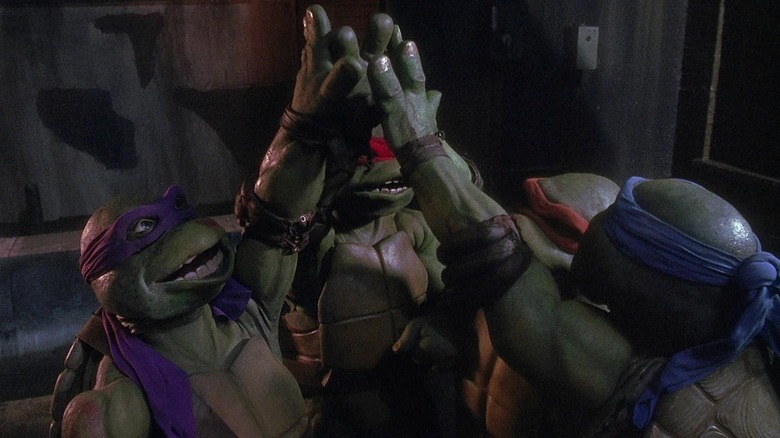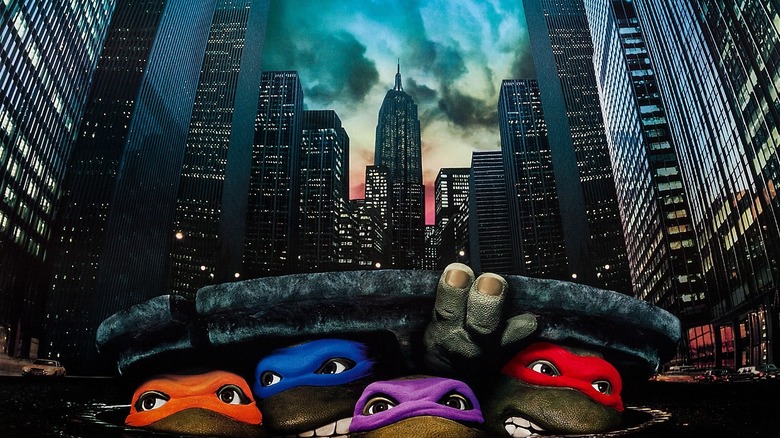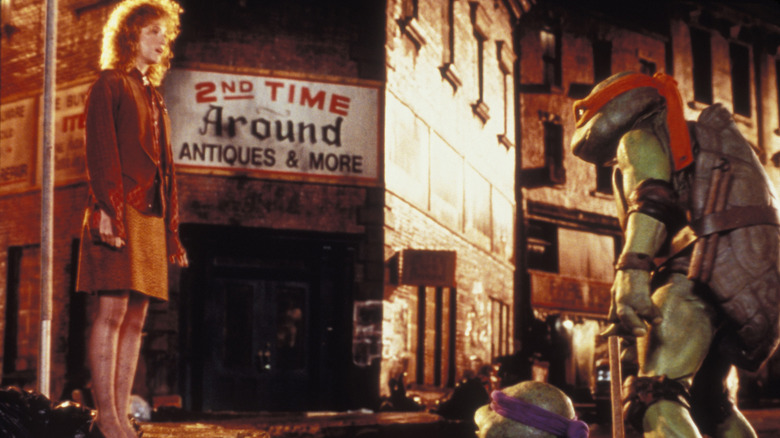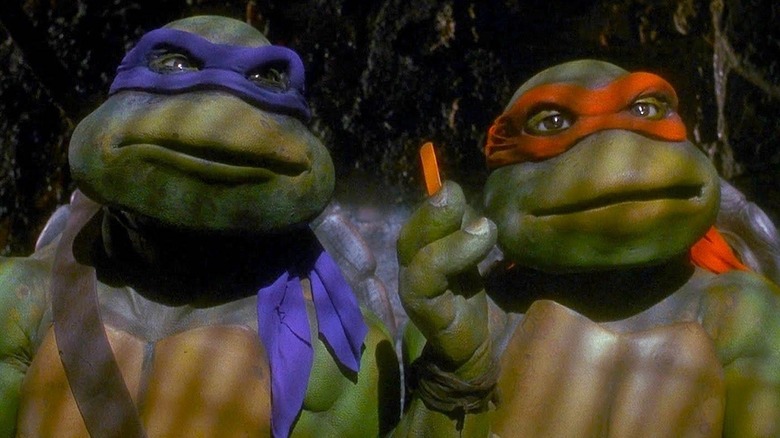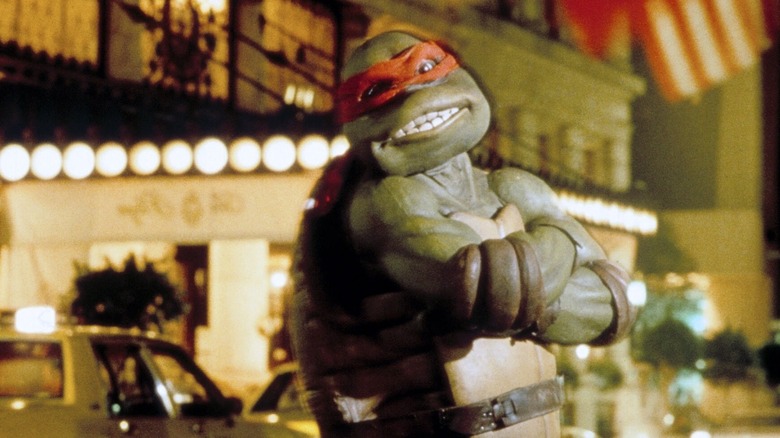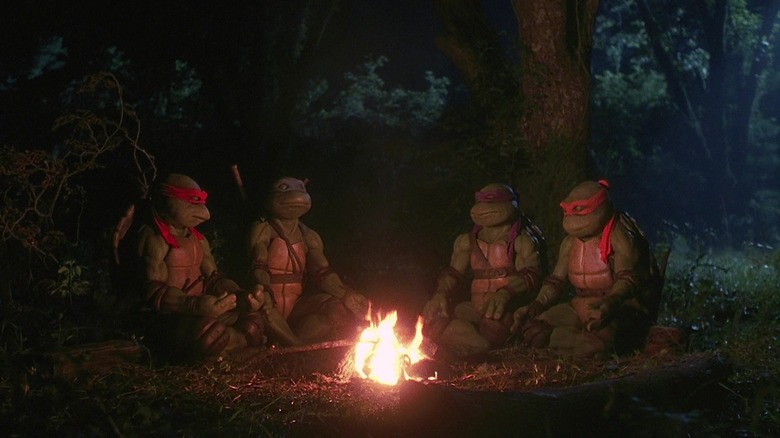35 Years Ago, An Unsuspecting Comic Book Movie Became A Box Office Sensation
(Welcome to Tales from the Box Office, our column that examines box office miracles, disasters, and everything in between, as well as what we can learn from them.)
"One of my first calls was to Peter Chernin, who went on to run Fox for a long time. But Peter goes, 'Are you guys out of your minds?'" That's producer Kim Dawson recalling to The Hollywood Reporter in 2015 how things went in the early going when they were trying to secure funding for "Teenage Mutant Ninja Turtles" in the late '80s. "Howard the Duck was just released. Nobody felt like a comic book could be converted into a live-action character."
Indeed, this was a very different time for comic book movies in Hollywood. Richard Donner's "Superman" had come and gone. That was viewed as more of a one-off. There was no reason to believe a movie about walking, talking, giant turtles who know martial arts could work. Even just reading that sentence, it's easy to see why the money men at various studios felt this was a doomed idea. Persistence, however, would pay off handsomely for all involved.
In this week's Tales from the Box Office, we're looking back at 1990's "Teenage Mutant Ninja Turtles" in honor of its 35th anniversary. We'll go over how it came to be, why nobody wanted to make the movie in the first place, how difficult the production itself was, what happened when it hit theaters, what transpired in the aftermath of its release, and what lessons we can learn from it all these years later. Let's dig in, shall we?
The movie: Teenage Mutant Ninja Turtles (1990)
"When you think back in the days where we weren't sure if we'd sell enough copies of the first issue to pay back our uncle, who loaned us the money for the first issue," co-creator Kevin Eastman said to /Film in 2023. Eastman, along with Peter Laird, originally made a black and white, violent comic book that was sort of a parody of Marvel's "Daredevil." It was an independent book and, as Eastman pointed out, it wasn't exactly a huge hit at first.
But when the "Ninja Turtles" animated series hit the airwaves in the '80s, things changed. Mikey, Donnie, Raph, and Leo were now very popular. An animated TV show is one thing, though. A full-blown live-action movie? That's another thing entirely. At one point, B-movie maestro Roger Coorman was looking to make a "Ninja Turtles" movie, which would have been a very low-budget affair, possibly starring comedians such as Sam Kinison and Billy Crystal.
That never came to pass, but Dawson saw the vision and enlisted Bobby Herbeck ("Small Wonder") to pen the screenplay. They also got Chinese production company Golden Harvest on board, with the hope being that they could make a cheap action movie for around $3 million, albeit one with guys in rubber suits. It didn't exactly pan out that way in the end.
When it came to selecting a director for the project, which still didn't have a distributor, they went with an unconventional choice. Namely Steve Barron, kwho was nown best for his work in music videos at the time.
Making a comic book movie that nobody wanted to make
"I didn't want to do something that was bloody," Barron said in that same THR 2015 retrospective. "Funnily enough, Batman came out at the same time. It was that sort of tone I was already aiming for. The films that I loved, there was a sense of humor but a sense of peril as well. Of real peril, of grounded peril. Like something that had repercussions for what you did but had a wonderful sense of fun with it."
Indeed, around this same time, Tim Burton's "Batman" movie came out in 1989 and became a smash hit. But when they were trying to pull funding together for "TMNT" around 1988, things were different. Comic book movies were very far from a sure thing, and movies like "Howard the Duck" only served to illustrate that live-action adaptations weren't good investments.
As costs began to elevate, the production ran into trouble. The $3 million action movie version was long gone. A deal with Fox had fallen through. Days before filming, they still needed lots of money. As Tom Gray, then-head of production at Golden Harvest, explained to THR in 2015:
"I had been talking to New Line. I called [New Line founder] Bob Shaye, and I said, 'I need $6 million to make the movie.' He said, 'You have nowhere else to go. We'll give you x,' and they gave me a lot less. Then Raymond Chow came up with the difference."
After the breakout success of Wes Craven's "A Nightmare on Elm Street" in 1984, New Line had established a name for itself, but they weren't in the big risk-taking business. So, the producers had to work with what they could come up with.
Becoming a Ninja Turtle
Remarkably, the producers managed to get Jim Henson and his creature shop to craft the turtles for the movie. It was no small task, but having Henson bring Leonardo, Donatello, Michelangelo, and Raphael, as well as Splinter, to life on screen was a godsend — even if it was expensive. Not to mention uncomfortable for the actors.
Josh Pais (Raphael), Michelan Sisti (Michelangelo), Leif Tilden (Donatello), and Brian Tochi (Leonardo) were the actors in the suits, though their voices would later be replaced by other actors, save for Pais. While that wasn't a popular decision, it was one the filmmakers felt they needed to make. Even so, it was these four men who brought the heroes in a half-shell to life, along with some talented martial artists. It was a painstaking process. From making the full body casts to preformation martial arts in 70-pound suits, it was tough sledding.
"I had this body cast, and I'm completely encased in papier-mâché. I have a straw in my nose, and these Brits are like whistling Dixie to me. That was the beginning of this surreal experience." Tilden explained to The Ringer in 2020. "We would just freak out, and you would hear one of us go, 'Take the head off! F****** take the head off! Take it off!' Your blood was literally boiling," Pais recalled in 2015 of the not-so-fun filming experience.
Be that as it may, with a budget of $13.5 million, a great deal of innovation, and a whole lot of behind-the-scenes squabbling, the team managed to get the movie in the can. They had a distribution deal with New Line. It was fated that these unlikely comic book heroes were going to help usher in the '90s.
The financial journey
New Line Cinema made a key decision not to release "Teenage Mutant Ninja Turtles" over the summer or during any holiday frame. Instead, they opted for a late March release date in an era long before Hollywood would turn March into a blockbuster month with movies like "The Hunger Games" and "Batman v Superman: Dawn of Justice," among many others. The coast was completely clear for this comic book movie nobody wanted to make to prove that it was a good idea. Fortunately, it didn't take long for the world to realize this idea was more than good.
"Teenage Mutant Ninja Turtles" hit theaters on March 30, 1990, and easily topped the box office on opening weekend, with a $25.3 million haul. The next-closest movie was Julia Roberts' romantic comedy "Pretty Woman" ($12.4 million), which was in its second weekend. Put simply, it was a home run, given that the opening weekend figure was nearly double the production budget.
Bannon's film stayed on top for most of April, eventually surrendering the crown to "Pretty Woman," oddly enough. By then, it hardly mattered as "Ninja Turtles" made an astounding $135.2 million domestically by the end of its run. At the time, it was the highest-grossing independent release in Hollywood history.
When taking international grosses into account, to date, the movie has made more than $200 million globally. Or roughly 15 times its budget. One imagines Bob Shaye was pretty happy with himself. Fox's loss was New Line's gain.
The Teenage Mutant Ninja Turtles become pop culture sensations
The thing about a hit movie is that it can be a here today, gone tomorrow situation. In the case of "Teenage Mutant Ninja Turtles," we're talking about a movie that generated a full-blown pop culture phenomenon. Merchandise, commercials, toys, video games, TV. They were everywhere. There was an infamous appearance on "The Oprah Winfrey Show," as well as the "Teenage Mutant Ninja Turtles: Coming Out of Their Shells Tour," and the less said about that, the better.
Naturally, a sequel happened in the form of 1991's truly bizarre "The Secret of the Ooze." It was also a big success, taking in $78.6 million against a $25 million budget. These movies helped to build a foundation that the rest of the franchise has grown from in the decades since. Multiple long-running animated shows, a pair of blockbuster movies produced by Michael Bay, more toys than anyone could hope to count, and 2023's acclaimed animated flick "Mutant Mayhem."
This iteration of the franchise flamed out after 1993's "Teenage Mutant Ninja Turtles III," but there were plans for a never-realized fourth movie. In any event, the little comic that Eastman and Laird struggled to make gave way to one of the most unlikely box office success stories of the '90s – if not ever. Moreover, it wouldn't be difficult to argue that this might just be the most unlikely global, multi-billion-dollar franchise ever.
The lessons contained within
In the years since this movie's release, comic book movies have become all the rage in Hollywood. When Sam Raimi's "Spider-Man" became the first movie to ever make $100 million on a single weekend in 2002, there was truly no going back. That movie, like "Ninja Turtles," was made through passion and innovation. The same can be said for the likes of "Iron Man" and "The Dark Knight."
What we're seeing now is that these movies are a bigger part of the blockbuster machine. That's part of what killed Michael Bay's "Teenage Mutant Ninja Turtles" movies, which were a rough experience for the actors to endure. The difference is that, for all of the suffering, the cast and crew still talk about the 1990 movie with reverence and love. They weren't just making something to cash in and keep a franchise alive.
As Marvel and DC struggle in their own ways in 2025 and beyond, it's perhaps worth taking a page out of this movie's book moving forward. No amount of money or universe-building can replace genuine enthusiasm and vision. It's highly unlikely that we get to a place where the "Ninja Turtles" are these enduring pop culture icons without this movie that was cobbled together through blood, sweat, and passion. Cowabunga dudes, as it were.
